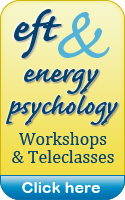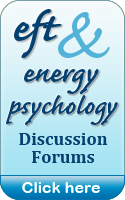Self-Healing for Children of All Ages
WHEE: Wholistic Hybrid derived from EMDR and EFT
By
Daniel J Benor, MD, Psychiatrist, Amer. Board Integrative Holistic Med
(Add or view comments at the bottom of the page.)
Clinical Explorations
In an earlier article I share in detail how WHEE was developed. (See Recommended reading, below.)
WHEE has been hugely successful for several reasons.
- WHEE takes a fraction of the time that EFT and related meridian based therapies require.
- WHEE does not stimulate heavy emotional releases that EMDR can evoke, while still clearing the buried angers, fears and hurts.
- WHEE allows for much greater flexibility in working on target problems within the session because it is so rapid. If the child is successful but the parent is not, or vice versa, there is plenty of time to explore alternative target symptoms or alternative methods of addressing these.
- WHEE is better accepted and the compliance outside the therapy room is much higher because of this simplicity.
- WHEE works marvelously well and rapidly, often within minutes, to relieve physical and emotional pains, anxieties, fears and cravings.
- WHEE is excellent for allergies, though it may take several days to be effective for these.
- WHEE is tremendously empowering, as it is so simple and so rapidly effective in self-healing.
Process
The practice of WHEE involves three steps:
- Identifying a feeling or thought we would like to change
We focus on a single incident that has left a negative residue of feeling. We assess how strong this is, on a scale from ‘0’ = This doesn’t bother me at all… to ‘10’ = This is the worst I could possibly feel. This is called the SUDS (Subjective Units of Distress Scale).
Younger children, who don’t know numbers yet, can show by holding their hands apart how big the bad feeling is.
- Alternating stimulating the right and left side of the body
This can be done by moving the eyes rhythmically, repeatedly, back and forth from right to left and back; by alternately tapping the right and left eyebrow at the point nearest the nose; by patting the biceps of each arm (a ‘butterfly hug’); or by any other rhythmic, right and left stimulation.
- While tapping or patting the body, we recite an affirmation
For younger children: “Even though I have this [thing I’m afraid of; bad feeling; hurt; pain; anger; etc.] I still love myself a lot.” If the parents and child feel comfortable with this, we can add a further strong positive statement, “and God loves and accepts me.”
A generic affirmation for older children, teens and adults, adapted from EFT: "Even though I have this [anxiety, panic, fear, etc. - be specific when filling in the blank], I wholly and completely love and accept myself, and God loves and accepts me wholly and completely and unconditionally. If any of this does not feel comfortable, we use whatever strong positive statement suits us best at the time we need it.
Most people will find that this is an effective way of reducing the negative feelings and thoughts. After tapping for a few minutes, we check the SUDS again. It will usually go down. We repeat the assessing and tapping until it is zero.
Next, we can build up a positive affirmation to replace the negative, by stating the positive statement as we tap; followed by the same strong positive part of the affirmation (“I love and accept… etc.”).
If the numbers don’t shift after we tap, we can give ourselves a gentle massage on the releasing spot, located just below the collar bone at its midpoint. No affirmation is needed here. Then we return to tapping.
Teenagers would often refuse to use any of these tapping approaches outside of the therapy room. Their typical comment was, "Sure, Dad! Like I'm going to tap my forehead or pat my arms in front of my friends! They'll think I'm some sort of nut case!" I speculated to myself that if they alternated tapping with their tongue on their teeth on the left and then on the teeth on the right this should work just as well, and found that indeed it does. This has been received much better by those who are shy or uncomfortable with tapping in public.
Holding our free hand over our heart center (chakra) while we tap or touch our eyebrow points deepens the effects. A deep breath following the affirmation also facilitates releases.
With adult clients I find the Sedona Method (www.Sedona.com) is an even faster approach. This involves simply asking clients whether they are prepared to let go of their problems and then inviting them to do so (with a structured series of questions that are trademarked by the Sedona teachers). I find that younger children don't respond as well to this approach.
Clinical example (assumed name, composite case):
Six-year old ‘Joe’ had been seriously abused emotionally, physically and sexually by his mother from at least the age of two and probably earlier. He was removed from her home at age four, and had nine foster home placements before his latest foster mother suggested to the welfare worker that counseling might be helpful to him for his temper outbursts, fighting children in his first grade class and after school, inability to fall asleep till past midnight, frequent nightmares and night terrors, and bedwetting – his more serious problems. In addition, he was unable to sit still, was impulsive, distractible, constantly forgetting and losing things, and had no friends.
I diagnosed PTSD (moderately severe) and possible attention deficit hyperactivity disorder (ADHD). I prescribed small doses of Ritalin, as this acts within minutes and, if effective, could provide rapid relief for some of his problems. He responded well to the medication and was much better able to sit and attend in class, less impulsive, and less forgetful. His other symptoms remained. He also had counseling sessions weekly with a social worker at the clinic where I work, focused on issues of relating to his foster family, multiple losses, and PTSD issues.
At the initial interview, I taught Joe and his foster mother to use the butterfly hug. Joe chose an affirmation about one of the bad memories he had of being left in the dark cellar by his mother. He was unable to count, so I had him show me with the gap between his hands how big his bad feeling was when he thought about being in the dark cellar. He opened his arms wide and said, "I can't reach to show you how big the bad feeling is." Within minutes of using the butterfly hug, his hands were touching in his SUDS. He had reduced the bad feelings to zero.
Over the next several weeks, Joe (with the help of his mother) used the butterfly hug daily on various fears, difficulty falling asleep, and after waking from nightmares, as well as to calm down after he had temper outbursts.
Within two months, Joe was functioning at near-normal levels of behavior in school and at home. Counseling continued for another four months and was discontinued. I have followed him for Ritalin prescriptions for several years and we have all been pleased with his excellent academic progress in school, and with his good behavioral and improved social adjustments in school and at home.
I have also had excellent results with proxy use of WHEE. In proxy treatments, the person receiving the treatment focuses her or his awareness on another person who is intended to receive the treatment. Therapists may do this on themselves as proxies for their clients. (While this may seem far-fetched, it has an excellent basis in research as distant healing (Benor 2001).
Clinical example: I visited a healer who was babysitting a six-year old boy who has developmental delays and may have mild autism. He was severely frightened by the healer's two dogs, which were lively and playful, and nearly as frightened of her two cats. He had been in the healer's home several times previously, and was constantly on the alert, if not alarmed, by any approach of the animals to within several feet. Within minutes of surrogate tapping for his fears of the animals, he was markedly less fearful, and within a few more minutes he was even able to pet the quieter dog. He had never been that calm before in the animals' presence, and certainly would not have petted them.
Children’s problems that have responded to WHEE
Angers – Preventive use of WHEE is best, emptying the ‘bucket of old angers’ so that it doesn’t overflow when new angers are stuffed inside; releasing anger and calming while sitting in a time out chair; addressing fears and hurts that may be associated with the angers.
Pains – Emotional distress following painful emotional experiences – both recent and from distant past, such as parental conflicts, separation or divorce, worries over family stresses such as illness, injuries and financial issues, bereavement; physical pains of all sorts, such as headaches, stomach aches, pains after injuries, toothaches, migraines. CAUTION: Pain may be a signal from the body that children are ‘up tight’ over a stressful situation and are in distress, but may be unaware of what it is that is stressing them. It is important to consider such possibilities carefully before working on removing the pain.
Fears – Anxieties about exploring new activities or going new places, including visits to dentists and doctors; fears of insects, snakes, pets and larger animals; test anxieties; performance anxieties, such as speaking in class or in public; specific fears following frightening or traumatic experiences; anxieties and fears about recurring experiences such as medical treatments, shifting between homes of parents who are not living together (See article on ‘Re-entry problems’ below); calming after waking from a nightmare.
Phobias, including school avoidance – even in severe cases where the child previously had to be dragged from the car by his parents and held by the vice principal so he wouldn’t run back to the car.
Motion sickness – can respond immediately and can be eliminated.
Allergies – to animals, pollens and other allergens; asthma. Allergies may respond within minutes or may take several weeks of regular WHEE use to dissipate.
Cravings – For sweets, food, drugs have all responded to WHEE.
Reducing the need for medications and their side effects – both in a secondary manner, with the reduction in severity of the issues for which the medications are prescribed (anxiety, pain, allergies, etc.); and in harmonizing the response to medications, such as chemotherapy.
Relationships, social issues, performance anxieties, low self-confidence – common issues of teens respond dramatically well to WHEE.
Parental anxieties and distress – Anxieties raised by children’s issues; anxieties not caused by the children but impacting the children because children pick up on parents’ worries or parents have a shorter fuse.
Clinical (composite) example
Pat brought her 5 1/2 year-old daughter, Cheryl, for psychiatric consultation because Cheryl was unmanageable at home or in her kindergarten. Her teacher had insisted that she have a consultation as a condition for continuing in the class – threatening to call in the Child Study Team if Pat did not comply. Cheryl was very distractible, unable to sit for more than two minutes without fidgeting, dropping things, talking with other children or getting out of her seat. She was irritable and at times had explosive temper outbursts, in which she was verbally and physically aggressive towards peers. She was obviously bright, as she was almost at class level in learning skills, despite her extreme restlessness. At home, Pat reported that she was similarly restless and very irritable.
In my office, she was responsive to questions but did not follow redirections from Pat or myself to stay in her chair, and was restless and intrusive. It appeared that she had most of the classical symptoms of attention deficit hyperactivity disorder (ADHD). However, on closer questioning, Pat clarified that these behaviors had begun only two months earlier. Previously, Cheryl had been an active but not a hyperactive child. Her behaviors changed when Pat and her husband, Mike, separated. While the separation was a peaceful one, and both parents remained fully involved with their daughter, Cheryl was clearly stressed by the changes. Pat reported that when Cheryl returned from weekend stays with her father she was even more unmanageable. For several days she could not settle at night till two or three hours past her bedtime. Her sleep was restless and she had frequent nightmares.
Pat was not keen on the medications her family physician had suggested, including a stimulant for the hyperactivity and Benadryl to put Cheryl to sleep. I fully agreed with her that in view of the upset having followed the separation, counseling approaches seemed more appropriate. Pat and Cheryl were very open to my suggestion of exploring how WHEE might help. We asked Cheryl what was most upsetting to her about her parents’ separation. She replied that she was frightened, when the baby sitter was there after school, that Pat wouldn’t come home any more, just like her father wasn’t coming home any more. Pat responded, defensively, that she had repeatedly explained to Cheryl that that wouldn’t happen, but that Cheryl just wouldn’t believe her. I asked Cheryl if she would like to be able to worry less about this, and she nodded, a little tearfully, in response. In response to my asking her how much she was worried about this, she held her hands as wide apart as she could.
Using the butterfly hug, I took Cheryl through two rounds of WHEE, at the end of which her hands were touching when I asked how much she was worried. I then asked her if she could think of something good about being alone with her mommy. She immediately responded, “I get to eat dinner with her alone, and she tells me stories over dinner.” We did three more rounds of WHEE, using the affirmation, “When I’m afraid my mommy won’t come home, I will remember eating dinner with her, and I love myself a lot, and God loves me too.” This brought her assessment of the strength of the positive statement up to as wide as she could hold her hands.
At the same time, Pat worked on an issue of her own – which she did not share in front of Cheryl. The feeling was “sad and angry” and she managed to bring it down from a 9 to a 5, working in parallel with Cheryl. Pat needed to massage the point under her collar bone when the number would not shift, and was pleased to see progress after that. Cheryl was proud that she was able to work more quickly on her problem than her mommy was.
Pat proceeded to use WHEE with Cheryl to help her settle at night. Within three days she was sleeping normally, though she needed to address this several more times after weekend visits with her father. Cheryl used WHEE successfully for calming after nightmares, and sometimes used it spontaneously in school when upset. Within 3 weeks Cheryl was much calmer and no longer unmanageable in class.
Pat also reported marked benefits for herself in using WHEE – to release negative feelings surrounding the separation. She taught Mike how to help Cheryl with WHEE, and he reported similar benefits for himself.
The above is a very common scenario. One of the strengths of WHEE is that it is so rapidly and potently effective that people immediately see its benefits and are motivated to persist and use it for more and more issues in their lives. Within families, as one person has successes, others are encouraged to continue using WHEE themselves. They will often discover new ways to apply WHEE and are helpful to each other in tweaking the affirmations for maximal benefits.
Effectiveness of WHEE
I find that 85-90 percent of clients obtain immediate benefits from WHEE. When they practice this for their problems at home, there is almost universal success. (The last observation may be a matter of self-selection.)
Children like and use WHEE because they can do it discretely, without anyone knowing they are doing it. When I was teaching children EFT they would often refuse to use it in front of other children because they got teased.
WHEE is empowering. It gives us a clear way to deal with almost any problem we might encounter that raises negative feelings. It helps to clear the ‘bucket’ of emotional ‘junk’ - that place inside where we stuff unresolved feelings when we don't know how to resolve a stressful situation.
WHEE helps to forgive others for their transgressions, helps us to forgive ourselves for not having done better than our best at the time when we stuffed feelings into our inner ‘bucket,’ and to accept that we did the best we could at the time and now are more competent to deal with the residues of the situation that left us with bad feelings.
Where it doesn't work, the most frequent problems are:
1. The child or adult has not focused the problem accurately in wording the affirmation.
2. They are reporting that the memory has not faded. This is an incorrect expectation, as it is the negative feelings about the memory that fade, not the factual memory.
3. They have forgotten to massage the releasing point when there is a block in the process.
4. They have unconscious reasons for holding onto some or all of the symptoms. Once we identify what these are, many of them are also responsive to WHEE. (This is dealt with in further sessions, using kinesiology to tap into unconscious issues and motivations – the subject for a future article.)
If the above do not apply, the few remaining clients may need professional counseling to identify and sort out the issues.
Many of my clients are children. I invite parents to use WHEE to explore and practice releasing old hurts and fears together with their children. I believe that when families work together there can be multiplied changes for each individual in the family.
I have had enthusiastic feedback on successes from therapists who learned WHEE through lectures and workshops that I teach internationally.
I offer telephone tutorials in WHEE, limited to 10 participants, with a money-back guarantee if you have used WHEE as recommended and have not had any benefits.
Theoretical considerations and conclusions
EMDR has a solid basis in research, demonstrating its efficacy in treating stress related disorders (www.emdr.org). The American Psychiatric Association has acknowledged EMDR as equivalent to Cognitive Behavioral Therapy (CBT) in treating severe post traumatic stress. EFT and related therapies are still in preliminary stages of organizing research. WHEE, drawing from EMDR (though clearly not following the standard EMDR protocols), can claim to have a research base to support its efficacy. See also extensive reports of children’s problems responding to EFT at http://www.emofree.com/children.htm.
Having advocated for the abbreviated procedure of WHEE, let me step back and add that I do not see this as a ‘cure-all.’ I find that EMDR, EFT and related therapies are outstanding for addressing focal traumas, fears, pains, allergies, and beliefs. The therapist is equally important as the form or modality of therapy. If you have a therapist you get along with, this is a remedy in itself!
For others, deeper levels of work may require more elaborate approaches. I have found selected clients who want or need deeper levels of work. In my own work as a wholistic psychiatric psychotherapist, I offer help with body (including medications as needed), emotions, mind, relationships and spirit. I have a particular interest in integrating spiritual awareness and healing, along with many other wholistic approaches in my practice, matching the therapy to the individual needs of the client. My book, How Can I Heal What Hurts? describes many of these methods and offers suggestions for many other self-healing techniques.
Disclaimer: The techniques described in this article are intended as information about treatments, not for self-treatment. If you are having stress problems, you should seek the help of a therapist who can guide you in identifying and using the techniques that will best suit your problems.
View All Articles by this Author
Author's Bio:
My bio summarizes my ongoing search for ever more ways to peel the onion of life's resistances, to reach the knowing (with the inner knowing of truth which has the feel of rightness) that we are all cells in the body of the Infinite Source.
While my unique area of expertise is spiritual awareness and healing, my principal work is through wholistic healing – addressing spirit, relationships (with other people and the environment), mind, emotions and body. I am using WHEE, a potent self-healing method, with children and adults who are dealing with PTSD and other forms of stress, psychological and physical pain, low self-esteem, cravings and other issues.
Daniel J. Benor, MD, ABIHM, is a wholistic psychiatric psychotherapist who blends in his therapy elements from intuitive and spiritual awareness, spiritual healing (as in Reiki and Therapeutic Touch), WHEE - Wholistic Hybrid derived from EMDR and EFT (www.paintap.com); transactional analysis, gestalt therapy, hypnotherapy, meditation, imagery and relaxation, dream analysis, and other approaches. Dr. Benor has taught this spectrum of methods internationally for 35 years to people involved in wholistic, intuitive, and spiritual approaches to caring, health and personal development.
Dr. Benor founded The Doctor-Healer Network in England and North America. He is the author of 7 Minutes to Natural Pain Release, Healing Research, Volumes I-III and many articles on wholistic, spiritual healing. He is the editor of the peer reviewed International Journal of Healing and Caring - On Line (www.ijhc.org) and moderator of www.WholisticHealingResearch.com, a major informational website on spiritual awareness, healing and CAM research.
He appears internationally on radio and TV. He is a Founding Diplomat of the American Board of Integrative Holistic Medicine, Founder and Past Coordinator for the Council for Healing, a non-profit organization that promotes awareness of spiritual healing (www.councilforhealing.org), and for many years on the advisory boards of the journals, Alternative Therapies, Subtle Energies (ISSSEEM), Frontier Sciences, Explore, the Advisory Council of the Association for Comprehensive Energy Psychotherapy (ACEP), Emotional Freedom Techniques (EFT) and the Advisory Board of the Research Council for Complementary Medicine (UK), Core reviewer for BioMed Central, Complementary and Alternative Medicine – On line.
2 Comments
Jose Goyo-EFT cert 1
Posted October 02, 2010 06:18 PM
thank , i started to practice pretty soon i will commet about resutls
A question ┐How long should we tap on step 2 and 3? thank again
Dan
Posted October 02, 2010 11:34 PM
Hi Jose,
WHEE is individualized to the needs and preferences of users. Most people tap for the duration of their statement of their affirmation + counteracting positive statement. Some like to tap longer - especially when they are working on intense issues.
Lots more about variations on the theme of WHEE in my book, Seven Minutes to Natural Pain Release at www.paintap.com and in WHEE-kly articles through a link on that site.
Blessings
Dan
db@paintap.com
Leave a Comment
Disclaimer: All information on this website is for educational purposes only, and the content is not intended to suggest that it is a
substitute for proper medical care or good common sense.
While EFT has produced remarkable clinical results, it must still be considered to be in the experimental stage
and thus practitioners and the public must take complete responsibility for their use of it.
In addition, the articles on this site represent the views of the authors and do not necessarily reflect those of the
founder of EFT, Gary Craig, nor the owner of this web site, Stefan Gonick.
|





 EFT never ceases to amaze me! The process is gentle and often provides benefits where other methods fail.
EFT never ceases to amaze me! The process is gentle and often provides benefits where other methods fail.

